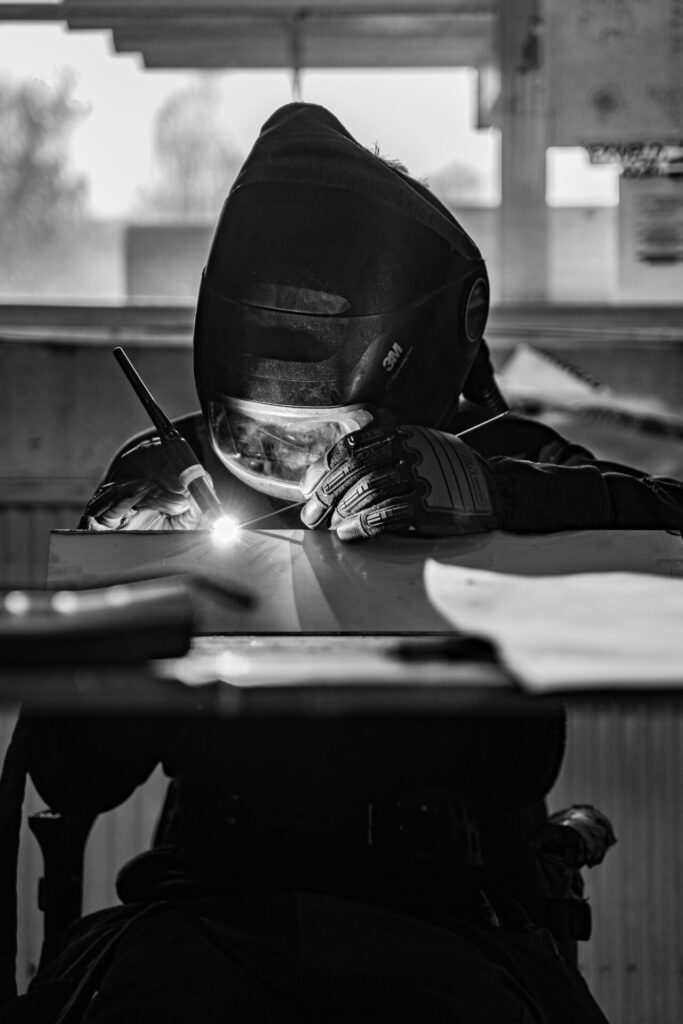TIG welding gloves are an essential piece of equipment for anyone who wants to keep their hands safe and protected while welding. Welding is a challenging and demanding job that requires precision and attention to detail. In order to ensure that welders can perform their tasks with ease and comfort, it’s crucial to have the right gear, especially when it comes to gloves.
Table of Contents
This page contains affiliate links in which we receive a small commission at no additional cost to you. As an Amazon Associate I earn from qualifying purchases.
What is TIG Welding?
TIG welding, also known as Tungsten Inert Gas welding, is a type of welding process that uses a non-consumable tungsten electrode to produce the weld.
This welding process is characterized by its high precision and control, making it ideal for welding thin materials and delicate structures. TIG welding uses an electric arc to heat the metal, which is then melted and combined to form the weld.
A shielding gas, typically argon, is used to protect the weld from oxidation and contamination. TIG welding is often used for welding stainless steel, aluminum, and other non-ferrous metals, and is particularly well-suited for welding in tight spaces or for creating intricate, highly detailed welds.
What is TIG Welding?
TIG welding, also known as Tungsten Inert Gas welding, is a type of welding process that uses a non-consumable tungsten electrode to produce the weld.
This welding process is characterized by its high precision and control, making it ideal for welding thin materials and delicate structures. TIG welding uses an electric arc to heat the metal, which is then melted and combined to form the weld.
A shielding gas, typically argon, is used to protect the weld from oxidation and contamination. TIG welding is often used for welding stainless steel, aluminum, and other non-ferrous metals, and is particularly well-suited for welding in tight spaces or for creating intricate, highly detailed welds.

TIG welding is a favorite among scrap metal artists because of its versatility and ability to weld without adding filler metal.
What Makes TIG Welding Gloves Different from Other Welding Gloves?
TIG welding gloves are different from other welding gloves in several ways. First, they are designed to provide the welder with a high level of sensitivity and dexterity, allowing them to perform delicate welding tasks with ease. These gloves are usually made from a thin and flexible material, such as leather or goat skin, which makes them much more comfortable to wear than other types of welding gloves.
Another key difference between TIG welding gloves and other welding gloves is the level of protection they provide. TIG welding gloves are specifically designed to protect the welder’s hands from high heat that is common during TIG welding. This is achieved through the use of materials that have high heat resistance and flame resistance, such as aluminized fibers or para-aramid fibers.
TIG gloves may also include extra heat protection below the pinky finger, as this portion of the hand is often resting on the metal being welded.
Why are TIG Welding Gloves Important?
TIG welding gloves are important because they provide welders with essential protection against the hazards of TIG welding. Without the right gloves, welders are at risk of burns, cuts, and other types of injuries that can be caused by high heat, sparks, and molten metal. TIG welding gloves also help to prevent exposure to hazardous chemicals, such as fumes and gases, which can be harmful to a welder’s health.
In addition to protecting the welder’s hands, TIG welding gloves also help to improve the overall quality of the welding job. With the right gloves, welders can work with more precision and accuracy, which results in better quality welds. This is why TIG welding gloves are an essential part of any welder’s protective gear and should never be overlooked.

What are TIG Welding Gloves Made of?
TIG gloves are typically made from a combination of materials, including leather, goat skin, aluminized fibers, para-aramid fibers, and more.
The specific materials used in gloves for TIG welding can vary depending on the manufacturer, the type of TIG welding being performed, as well as the level of protection and dexterity required.
Leather: Leather is a common material used in welding gloves because of its durability, heat resistance, and flexibility. Cowhide and deerskin are two types of leather that are commonly used in TIG welding gloves.
Goat Skin: Goat skin is another popular material used in TIG welding gloves due to its thin and flexible texture. This material allows for a high degree of dexterity and sensitivity, making it ideal for TIG welding.
Aluminized Fibers: Aluminized fibers are a type of material that is often used in welding gloves for their heat resistance and flame-retardant properties. Aluminized fibers are typically made from a combination of metal and textile fibers, which provide excellent heat protection.
Para-Aramid Fibers: Para-aramid fibers, such as Kevlar, are another type of material that is used in TIG welding gloves. Para-aramid fibers are known for their high heat and cut resistance, making them an ideal choice.
In addition to these materials, TIG welding gloves may also contain other materials, such as spandex, neoprene, or nitrile, to provide additional comfort, flexibility, and protection.
The choice of materials used in TIG welding gloves will depend on the specific needs and preferences of the welder, as well as the type of TIG welding being performed.
Recommended TIG Gloves
- Tillman offers affordable traditional goat skin gloves
- Defiant Metal ‘s offering features black leather that won’t appear as dirty as your typical white TIG gloves. These also feature extra protection between the pinky and wrist!
- Even Dewalt has a TIG glove option that follows the style of mechanics gloves. There is a long cuff and short cuff option
Of course there al also TIG welding glove options from most of the major welding companies, such as Miller and Lincoln
That’s a Wrap!
In conclusion, TIG welding gloves are a critical piece of equipment for any welder who wants to keep their hands safe and protected while welding. They provide the welder with a high level of sensitivity and dexterity, as well as essential protection against the hazards of TIG welding. So if you’re a welder, be sure to invest in a pair of high-quality gloves today!

